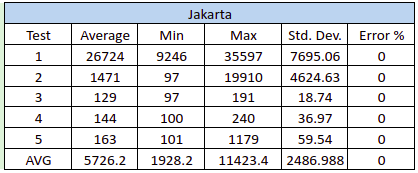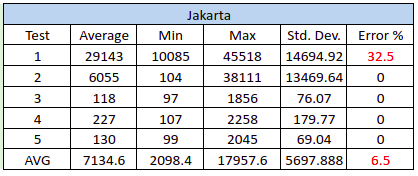Uvicorn和Gunicorn+Uvicorn有什么区别?
使用Uvicorn和天格洛氏Gunicorn+Uvicorn进行托管的天格洛氏Gunicorn+Uvicorn应用程序的部署有什么区别?为什么我的结果显示,仅使用Uvicorn部署的结果要比Gunicorn+Uvicorn更好?
当我在天格洛的文档中搜索时,它说:
您可以使用Gunicorn来管理Uvicorn并运行这些并发进程中的多个。这样,就可以充分利用并发性和并行性。
由此,我可以假设使用这个Gunicorn会得到一个更好的结果吗?
这是我使用JMeter进行的测试。我将脚本部署到Google运行中,结果是:
使用Python和Uvicorn:

使用Tiangolo的Gunicorn+Uvicorn:

这是我的Python Dockerfile (Uvicorn):
FROM python:3.8-slim-buster
RUN apt-get update --fix-missing
RUN DEBIAN_FRONTEND=noninteractive apt-get install -y libgl1-mesa-dev python3-pip git
RUN mkdir /usr/src/app
WORKDIR /usr/src/app
COPY ./requirements.txt /usr/src/app/requirements.txt
RUN pip3 install -U setuptools
RUN pip3 install --upgrade pip
RUN pip3 install -r ./requirements.txt --use-feature=2020-resolver
COPY . /usr/src/app
CMD ["python3", "/usr/src/app/main.py"]这是Tiangolo的Gunicorn+Uvicorn的Dockerfile:
FROM tiangolo/uvicorn-gunicorn-fastapi:python3.8-slim
RUN apt-get update && apt-get install wget gcc -y
RUN mkdir -p /app
WORKDIR /app
COPY ./requirements.txt /app/requirements.txt
RUN python -m pip install --upgrade pip
RUN pip install --no-cache-dir -r /app/requirements.txt
COPY . /app您可以从Tiangolo的Gunicorn+Uvicorn中看到错误。是由Gunicorn引起的吗?
编辑。
因此,在我的例子中,我使用延迟加载方法来加载我的机器学习模型。这是我的类来加载模型。
class MyModelPrediction:
# init method or constructor
def __init__(self, brand):
self.brand = brand
# Sample Method
def load_model(self):
pathfile_model = os.path.join("modules", "model/")
brand = self.brand.lower()
top5_brand = ["honda", "toyota", "nissan", "suzuki", "daihatsu"]
if brand not in top5_brand:
brand = "ex_Top5"
with open(pathfile_model + f'{brand}_all_in_one.pkl', 'rb') as file:
brand = joblib.load(file)
else:
with open(pathfile_model + f'{brand}_all_in_one.pkl', 'rb') as file:
brand = joblib.load(file)
return brand这是我的API端点。
@router.post("/predict", response_model=schemas.ResponsePrediction, responses={422: schemas.responses_dict[422], 400: schemas.responses_dict[400], 500: schemas.responses_dict[500]}, tags=["predict"], response_class=ORJSONResponse)
async def detect(
*,
# db: Session = Depends(deps.get_db_api),
car: schemas.Car = Body(...),
customer_id: str = Body(None, title='Customer unique identifier')
) -> Any:
"""
Predict price for used vehicle.\n
"""
global list_detections
try:
start_time = time.time()
brand = car.dict()['brand']
obj = MyModelPrediction(brand)
top5_brand = ["honda", "toyota", "nissan", "suzuki", "daihatsu"]
if brand not in top5_brand:
brand = "non"
if usedcar.price_engine_4w[brand]:
pass
else:
usedcar.price_engine_4w[brand] = obj.load_model()
print("Load success")
elapsed_time = time.time() - start_time
print(usedcar.price_engine_4w)
print("ELAPSED MODEL TIME : ", elapsed_time)
list_detections = await get_data_model(**car.dict())
if list_detections is None:
result_data = None
else:
result_data = schemas.Prediction(**list_detections)
result_data = result_data.dict()
except Exception as e: # noqa
raise HTTPException(
status_code=500,
detail=str(e),
)
else:
if result_data['prediction_price'] == 0:
raise HTTPException(
status_code=400,
detail="The system cannot process your request",
)
else:
result = {
'code': 200,
'message': 'Successfully fetched data',
'data': result_data
}
return schemas.ResponsePrediction(**result)回答 1
Stack Overflow用户
发布于 2022-03-20 12:41:30
古尼坎是一个支持WSGI标准的应用服务器。这意味着Gunicorn可以为用Flask或Django等框架编写的应用程序提供服务(2021年以前发布的版本更适合)。它的工作方式是指它创建并维护它们的可操作性,这是一个可配置的应用程序实例(也称为工作实例),它为客户端的请求提供服务。Gunicorn本身与FastAPI不兼容,因为FastAPI使用了新的阿斯吉标准。
乌维霍恩是一个支持阿斯吉协议的应用服务器。然而,作为一个过程(工人)经理,它的能力还有很多需要改进的地方。
但是Uvicorn有一个与Gunicorn兼容的工薪阶层。使用这种组合,Gunicorn将充当进程管理器,监听端口和IP。它将把通信发送给运行Uvicorn类的工作进程。然后,与Gunicorn兼容的Uvicorn工人类将负责将Gunicorn发送的数据转换为FastAPI使用的ASGI标准。
如果您有一个具有Kubernetes、Docker或其他类似复杂系统的集群来管理多台机器上的分布式容器,那么您可能希望在集群级别处理复制,而不是在每个容器中使用流程管理器(比如Gunicorn和workers)。像Kubernetes这样的分布式容器管理系统通常有一些处理容器复制的集成方法,同时仍然支持传入请求的负载平衡。都在集群级别。在这些情况下,您可能希望从头构建一个Docker映像,安装您的依赖项,并运行一个Uvicorn进程,而不是使用Uvicorn工人运行Gunicorn之类的程序。
https://stackoverflow.com/questions/66362199
复制相似问题

